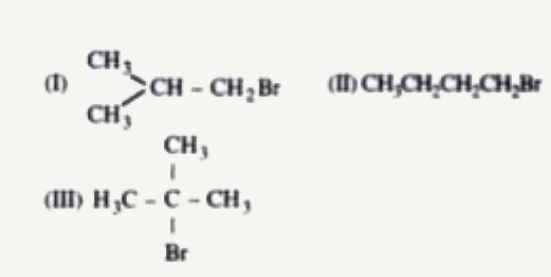Arrange each set of compounds in order of increasing boiling point : Propane, 1-chloropropane, isopropylchloride, 1-chlorobutane.
To arrange the compounds propane, 1-chloropropane, isopropyl chloride, and 1-chlorobutane in order of increasing boiling point, we need to consider the molecular structure, molecular mass, and branching of each compound. Here’s the step-by-step solution:
Step 1: Identify the Structures
1. Propane (A): CH3CH2CH3
2. 1-Chloropropane (B): CH3CH2CH2Cl
3. Isopropyl Chloride (C): CH3CHClCH3
4. 1-Chlorobutane (D): CH3CH2CH2CH2Cl
Step 2: Analyze Molecular Mass and Surface Area
- Propane has the lowest molecular mass since it contains only carbon and hydrogen.
- 1-Chloropropane and 1-Chlorobutane contain chlorine, which increases their molecular mass compared to propane.
- Isopropyl Chloride is branched, which generally lowers the boiling point due to reduced surface area.
Step 3: Determine the Effect of Branching
- Propane (A) is unbranched and has the lowest boiling point due to its lower molecular mass.
- Isopropyl Chloride (C) is branched, which means it will have a lower boiling point than the straight-chain compounds.
- 1-Chloropropane (B) and 1-Chlorobutane (D) are straight-chain compounds. However, 1-Chlorobutane has a higher molecular mass and larger surface area compared to 1-Chloropropane.
Step 4: Arrange in Order of Increasing Boiling Point
Based on the analysis:
1. Propane (A) - lowest boiling point
2. Isopropyl Chloride (C) - next higher boiling point due to branching
3. 1-Chloropropane (B) - higher boiling point than isopropyl chloride due to a straight chain
4. 1-Chlorobutane (D) - highest boiling point due to the longest chain and highest molecular mass
Final Order
The order of increasing boiling point is:
A (Propane) < C (Isopropyl Chloride) < B (1-Chloropropane) < D (1-Chlorobutane)
1. Propane (A): CH3CH2CH3
2. 1-Chloropropane (B): CH3CH2CH2Cl
3. Isopropyl Chloride (C): CH3CHClCH3
4. 1-Chlorobutane (D): CH3CH2CH2CH2Cl
- Propane has the lowest molecular mass since it contains only carbon and hydrogen.
- 1-Chloropropane and 1-Chlorobutane contain chlorine, which increases their molecular mass compared to propane.
- Isopropyl Chloride is branched, which generally lowers the boiling point due to reduced surface area.
- Propane (A) is unbranched and has the lowest boiling point due to its lower molecular mass.
- Isopropyl Chloride (C) is branched, which means it will have a lower boiling point than the straight-chain compounds.
- 1-Chloropropane (B) and 1-Chlorobutane (D) are straight-chain compounds. However, 1-Chlorobutane has a higher molecular mass and larger surface area compared to 1-Chloropropane.
Based on the analysis:
1. Propane (A) - lowest boiling point
2. Isopropyl Chloride (C) - next higher boiling point due to branching
3. 1-Chloropropane (B) - higher boiling point than isopropyl chloride due to a straight chain
4. 1-Chlorobutane (D) - highest boiling point due to the longest chain and highest molecular mass
The order of increasing boiling point is:
A (Propane) < C (Isopropyl Chloride) < B (1-Chloropropane) < D (1-Chlorobutane)
Topper's Solved these Questions
- BOOK - ICSECHAPTER - HALOALKANES AND HALOARENES EXERCISE - EXERCISE (PART - I OBJECTIVE QUESTIONS) (FILL IN THE BLANK)15videos
HALOALKANES AND HALOARENES
- BOOK - ICSECHAPTER - HALOALKANES AND HALOARENES EXERCISE - EXERCISE (PART - I OBJECTIVE QUESTIONS) (MULTIPLE CHOICE QUESTIONS)40videos
HALOALKANES AND HALOARENES
- BOOK - ICSECHAPTER - GENERAL PRINCIPLES AND PROCESSES OF ISOLATION OF ELEMENTS EXERCISE - EXERCISE (PART-I ( OBJECTIVE QUESTIONS )) (Fill in the blanks)60videos
GENERAL PRINCIPLES AND PROCESSES OF ISOLATION OF ELEMENTS
- BOOK - ICSECHAPTER - ISC QUESTION PAPEREXERCISE - PART-II(SECTION-B)74videos
ISC QUESTION PAPER
Similar Questions
Arrange each set of compounds in order of increasing boiling point : Bromomethane, bromoform, chloromethane, dibromomethane.
View SolutionArrange each set of compounds in order of increasing boiling points.
(i) Bromomethane, Bromoform, Chloromethane, Dibromomethane.
(ii) 1-Chloropropane, Isopropyl chloride, 1-Chlorobutane.View SolutionArrange the hydrides of group 16 elements in order of increasing boiling point.
View SolutionRank the following compounds in decreasing order of boiling points :
 View Solution
View SolutionArrange the following compounds in increasing order of their boiling points
View SolutionArrange the following compounds in increasing order of their boiling points.
 View Solution
View SolutionArrange the following compounds in order of: Decreasing SN1 reaction rate:
View SolutionArrange the given halogens in increasing order of boiling points.
View SolutionArrange the following in order of decreasing boiling point (i) Propan-1-ol (ii) propanal (ill) propanone (iv) Propane.
View SolutionArrange the following in order of decreasing boiling point (i) Propan-1-ol (ii) propanal (ill) propanone (iv) Propane.
View Solution

